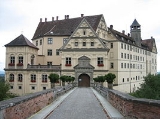
Heiligenberg
Encyclopedia
Heiligenberg is a municipality and a village in the Bodensee district in Baden-Württemberg
, about seven kilometres north of Salem, in Germany
.
and the Alps
, and is therefore also known as "the viewing terrace of the Lake," due to the altitude of the town, which is between 700 and 800 meters above sea level. In the summer there is, in contrast to the lake area, less sultry days and in winter the snow is much heavier, which is why in Heiligenberg and the surrounding area winter sports are popular. The areas geographic features and climate make Heiligenberg a nationally recognized health resort.
. Christianity
arrived at the village around AD 600 through the Irish
disciple Saint Gall
. It is unclear whether the name Heiligenberg comes from this period, or in pre-Christian times as a local place of worship.
1083 was the year Mons Sanctus was first mentioned. In the 13th century a local Count
built a castle. By 1535 the castle was in the possession of the Princely House of Fürstenberg
and became a magnificent chateau. It is still in possession of this noble family today.
Baden-Württemberg
Baden-Württemberg is one of the 16 states of Germany. Baden-Württemberg is in the southwestern part of the country to the east of the Upper Rhine, and is the third largest in both area and population of Germany's sixteen states, with an area of and 10.7 million inhabitants...
, about seven kilometres north of Salem, in Germany
Germany
Germany , officially the Federal Republic of Germany , is a federal parliamentary republic in Europe. The country consists of 16 states while the capital and largest city is Berlin. Germany covers an area of 357,021 km2 and has a largely temperate seasonal climate...
.
Location and climate
Heiligenberg (literally: the Holy Mountain or the Mountain of Saints) is located in the upper Linzgau region. Because of its location, Heiligenberg offers visitors an exceptional panoramic view of Lake ConstanceLake Constance
Lake Constance is a lake on the Rhine at the northern foot of the Alps, and consists of three bodies of water: the Obersee , the Untersee , and a connecting stretch of the Rhine, called the Seerhein.The lake is situated in Germany, Switzerland and Austria near the Alps...
and the Alps
Alps
The Alps is one of the great mountain range systems of Europe, stretching from Austria and Slovenia in the east through Italy, Switzerland, Liechtenstein and Germany to France in the west....
, and is therefore also known as "the viewing terrace of the Lake," due to the altitude of the town, which is between 700 and 800 meters above sea level. In the summer there is, in contrast to the lake area, less sultry days and in winter the snow is much heavier, which is why in Heiligenberg and the surrounding area winter sports are popular. The areas geographic features and climate make Heiligenberg a nationally recognized health resort.
History
Parts of the town area show traces of settlement from the Stone AgeStone Age
The Stone Age is a broad prehistoric period, lasting about 2.5 million years , during which humans and their predecessor species in the genus Homo, as well as the earlier partly contemporary genera Australopithecus and Paranthropus, widely used exclusively stone as their hard material in the...
. Christianity
Christianity
Christianity is a monotheistic religion based on the life and teachings of Jesus as presented in canonical gospels and other New Testament writings...
arrived at the village around AD 600 through the Irish
Irish people
The Irish people are an ethnic group who originate in Ireland, an island in northwestern Europe. Ireland has been populated for around 9,000 years , with the Irish people's earliest ancestors recorded having legends of being descended from groups such as the Nemedians, Fomorians, Fir Bolg, Tuatha...
disciple Saint Gall
Saint Gall
Saint Gall, Gallen, or Gallus was an Irish disciple and one of the traditionally twelve companions of Saint Columbanus on his mission from Ireland to the continent. Saint Deicolus is called an older brother of Gall.-Biography:...
. It is unclear whether the name Heiligenberg comes from this period, or in pre-Christian times as a local place of worship.
1083 was the year Mons Sanctus was first mentioned. In the 13th century a local Count
Count
A count or countess is an aristocratic nobleman in European countries. The word count came into English from the French comte, itself from Latin comes—in its accusative comitem—meaning "companion", and later "companion of the emperor, delegate of the emperor". The adjective form of the word is...
built a castle. By 1535 the castle was in the possession of the Princely House of Fürstenberg
Fürstenberg (princely family)
Fürstenberg is the name of a noble house in Germany, based primarily in southern Baden-Württemberg. The family derives its name from the fortified town of the line's founder, Count Heinrich von Fürstenberg, today part of Hüfingen...
and became a magnificent chateau. It is still in possession of this noble family today.

